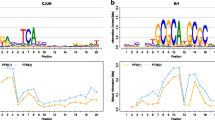Abstract
As an increasing number of eukaryotic genomes are being sequenced, comparative studies aimed at detecting regulatory elements in intergenic sequences are becoming more prevalent. Most comparative methods for transcription factor (TF) binding site discovery make use of global or local alignments of orthologous regulatory regions to assess whether a particular DNA site is conserved across related organisms, and thus more likely to be functional. Since binding sites are usually short, sometimes degenerate, and often independent of orientation, alignment algorithms may not align them correctly. Here, we present a novel, alignment-free approach for incorporating conservation information into TF motif discovery. We relax the definition of conserved sites: we consider a DNA site within a regulatory region to be conserved in an orthologous sequence if it occurs anywhere in that sequence, irrespective of orientation. We use this definition to derive informative priors over DNA sequence positions, and incorporate these priors into a Gibbs sampling algorithm for motif discovery. Our approach is simple and fast. It does not require sequence alignments, nor the phylogenetic relationships between the orthologous sequences, and yet it is more effective on real biological data than methods that do.
Preview
Unable to display preview. Download preview PDF.
Similar content being viewed by others
References
Kellis, M., et al.: Sequencing and comparison of yeast species to identify genes and regulatory elements. Nature 432, 241–254 (2003)
Cliften, P., et al.: Finding functional features in Saccharomyces genomes by phylogenetic footprinting. Science 301, 71–76 (2003)
Clark, A., et al.: Proposal for Drosophila as a model system for comparative genomics (2003), http://flybase.net/.data/docs/CommunityWhitePapers/GenomesWP2003.html
Blanchette, M., Tompa, M.: FootPrinter: a program designed for phylogenetic footprinting. Nucleic Acids Research 31, 3840–3842 (2003)
Newberg, L.A., et al.: A phylogenetic Gibbs sampler that yields centroid solutions for cis-regulatory site prediction. Bioinformatics 23, 1718–1727 (2007)
Harbison, C., et al.: Transcriptional regulatory code of a eukaryotic genome. Nature 431, 99–104 (2004)
MacIsaac, K.D., et al.: An improved map of conserved regulatory sites for Saccharomyces cerevisiae. BMC Bioinformatics 7, 113 (2006)
Wang, T., Stormo, G.D.: Combining phylogenetic data with co-regulated genes to identify regulatory motifs. Bioinformatics 19, 2369–2380 (2003)
Sinha, S., Blanchette, M., Tompa, M.: PhyME: A probabilistic algorithm for Finding Motifs in Sets of Orthologous Sequences. BMC Bioinformatics 5, 170 (2004)
Siddharthan, R., Siggia, E.D., van Nimwegen, E.: PhyloGibbs: A Gibbs sampling motif finder that incorporates phylogeny. PLoS Comp. Biol. 1, e67 (2005)
Prakash, A., Blanchette, M., Sinha, S., Tompa, M.: Motif discovery in heterogeneous sequence data. In: PSB 2004, pp. 348–359 (2004)
Moses, A., Chiang, D., Eisen, M.: Phylogenetic motif detection by expectation-maximization on evolutionary mixtures. In: PSB 2004, pp. 324–335 (2004)
Liu, Y., et al.: Eukaryotic regulatory element conservation analysis and identification using comparative genomics. Genome Research 14, 451–458 (2004)
Siepel, A., et al.: Evolutionarily conserved elements in vertebrate, insect, worm, and yeast genomes. Genome Res. 15, 1034–1050 (2005)
Chin, C., Chuang, J.H., Li, H.: Genome-wide regulatory complexity in yeast promoters: Separation of functionally conserved and neutral sequence. Genome Res. 15, 205–213 (2005)
Siggia, E.: Computational methods for transcriptional regulation. Current Opinion in Genetics & Development 15, 214–221 (2005)
Morgenstern, B.: A space-efficient algorithm for aligning large genomic sequences. Bioinformatics 16, 1531–1539 (2000)
Narlikar, L., Gordân, R., Ohler, U., Hartemink, A.: Informative priors based on transcription factor structural class improve de novo motif discovery. Bioinformatics 392, e384–e392 (2006)
Narlikar, L., Gordân, R., Hartemink, A.: Nucleosome Occupancy Information Improves de novo Motif Discovery. In: Speed, T., Huang, H. (eds.) RECOMB 2007. LNCS (LNBI), vol. 4453, pp. 107–121. Springer, Heidelberg (2007)
Narlikar, L., Gordân, R., Hartemink, A.: A Nucleosome-Guided Map of Transcription Factor Binding Sites in Yeast. PLoS Computational Biology 3, e215 (2007)
Gordân, R., Hartemink, A.: Using DNA duplex stability information to discover transcription factor binding sites. In: PSB 2008, vol. 13, pp. 453–464 (2008)
Bailey, T., Elkan, C.: Fitting a mixture model by expectation maximization to discover motifs in biopolymers. In: ISMB 1994, pp. 28–36 (1994)
Liu, J.: The collapsed Gibbs sampler with applications to a gene regulation problem. Journal of the American Statistical Association 89, 958–966 (1994)
Dorrington, R.A., Cooper, T.G.: The DAL82 protein of Saccharomyces cerevisiae binds to the DAL upstream induction sequence (UIS). Nucleic Acids Research 21, 3777–3784 (1993)
Jia, Y., Rothermel, B., Thornton, J., Butow, R.A.: A basic helix-loop-helix-leucine zipper transcription complex in yeast functions in a signaling pathway from mitochondria to the nucleus. Molecular and Cellular Biology 17, 1110–1117 (1993)
Li, X., Wong, W.H.: Sampling motifs on phylogenetic trees. PNAS 102, 9481–9486 (2005)
Brudno, M., et al.: LAGAN and Multi-LAGAN: efficient tools for large-scale multiple alignment of genomic DNA. Genome Res. 13, 721–731 (2003)
Siddharthan, R.: Sigma: multiple alignment of weakly-conserved non-coding DNA sequence. BMC Bioinformatics 7, 143 (2006)
Elemento, O., Tavazoie, S.: Fast and systematic genome-wide discovery of conserved regulatory elements using a non-alignment based approach. Genome Biology 6, R18 (2005)
Cliften, P.F., et al.: Surveying Saccharomyces genomes to identify functional elements by comparative DNA sequence analysis. Genome Res. 11, 1175–1186 (2001)
Author information
Authors and Affiliations
Editor information
Rights and permissions
Copyright information
© 2008 Springer-Verlag Berlin Heidelberg
About this paper
Cite this paper
Gordân, R., Narlikar, L., Hartemink, A.J. (2008). A Fast, Alignment-Free, Conservation-Based Method for Transcription Factor Binding Site Discovery. In: Vingron, M., Wong, L. (eds) Research in Computational Molecular Biology. RECOMB 2008. Lecture Notes in Computer Science(), vol 4955. Springer, Berlin, Heidelberg. https://doi.org/10.1007/978-3-540-78839-3_9
Download citation
DOI: https://doi.org/10.1007/978-3-540-78839-3_9
Publisher Name: Springer, Berlin, Heidelberg
Print ISBN: 978-3-540-78838-6
Online ISBN: 978-3-540-78839-3
eBook Packages: Computer ScienceComputer Science (R0)




